About
Neil Woodhall's Author Website
Exploring Our Place In Space
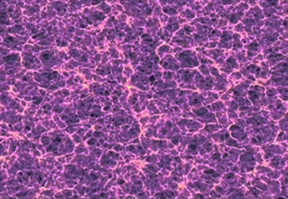
New View from Astronomy
The squiggly image above shows what the distribution of matter looks like in the known universe.
Dark regions are enormous voids. Bright dots are compact superclusters. Lavender threads form the cosmic web. Matter is pulled together by gravity, while superclusters are being pulled apart by expansion.
Current analysis suggests that the matter you see in this image will eventually fade away. What came before, and what will follow, are beyond the current grasp of science. Fiction fills those gaps.
These maps became available during the past twenty years. For the first time, we can actually visualize remote regions in true scientific detail. The following sections introduce a series of sky maps. Beginning with our own galaxy, we will move up through larger sizes, until we can imagine where our home planet is located, in the supercluster neighborhood where we live.
The stars in the sky have a new story to tell.
Index of Subjects
Part 1 – Neil Woodhall
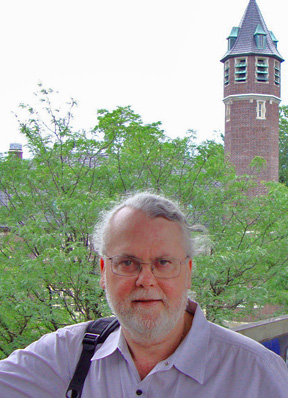
Why These Stories?
Every story follows its own path. An author finds a subject and then develops a theme. The book this author wrote had its origins in personal experience. Somewhere along the line, it morphed into something surprisingly different.
Neil Woodhall reached adulthood during the turbulent sixties. America was having a social civil war back then. For the next thirty years it seemed like things were getting better. Then America reignited that civil war. We need to figure out what we can do about that.
Which brings up an interesting question. Why do people get caught up in these mass movements? We have political clashes, horrific wars, religious fervor, as well as fashion fads. History provides plenty of examples.
Back then, I got caught up in one of those mass movements. We believed that we needed to make the world a better place to live. What eventually morphed into the Deep Time Stories has its roots in that social ferment. Our generation reached for the heights of possibility, before falling into the depths of dismay. It was the end of the sixties.
There is one iconic photograph which sums it all up. When the first humans landed on the Moon, they took pictures of down here from up there. One photo was a favorite all around the world – sunrise illuminating our planet against the darkness of outer space. Earth got nicknamed the Big Blue Marble in the Sky.
That gave us a larger view of our place in space. I never stopped wondering about what lay beyond that dark background.
In today’s culture wars, everything about the sixties gets attacked. My recollection is that people were about the same then, as now, except for one thing. During that brief historical spell – we had hope. World War Two was a recent memory. We hoped that our generation would be able to stop the madness. Hope got humiliated.
Back in 1968, when this amazing feeling of being connected to the grand cosmos was at its peak, I decided to write about it from personal experience. The giddy optimism we were feeling then was unlike anything I have ever experienced before, or since.
##
During the seventies. Stina and I got married. We raised three rambunctious boys and that kept us plenty busy. Throughout those years I always wrote but never had enough time to bring big projects to completion. Perhaps that was for the best. Instead of publishing my youthful impressions, I had many years to think about where I was going with my story.
The commuter train is how I traveled to work every day. That train ride became my research library. The story was always with me, constantly changing, being invigorated by the stress of fresh ideas. After a long struggle, the outline of the plot became clear.
A coincidence transformed my backstory into something I would never have imagined during my early years. While I was working on my manuscript, there was a group of astronomers who began their own work on a tremendous scientific challenge. Galaxies move through space. What needed explaining was why so many of those galaxies seemed to be moving toward the same spot, enormously far away. That remote location got named the Great Attractor.
What linked my fiction to their scientific advances were the sky maps they produced. As a boy, I watched the night stars with wonder. When I became a young man, I marveled at the Big Blue Marble. Nearing retirement, these recently published sky maps revealed what our cosmic neighborhood actually looks like. Wow! Those renderings are genuine, and that sent my imagination reeling.
The essence of my tale remained the same. Our planet is not isolated in the dark vastness of outer space. It is linked to multiple realities. That contradicts the narrow views of the authorities. They crushed us, and they plan on doing the same to every generation. Perhaps I’m an old fool, but I continue to believe that sharing this Larger View might replace their ancient ways of enless war.
The End of the Sixties put the first volume of these ideas into the public domain. Sequels will continue, with a similar cast of characters, set in the same fictional universe, facing an expanding series of troubles.
The sections which follow in this “About Page” are stepping-stones, which will take the reader down a multi-layered path, toward a better understanding our vast network of connectedness.
Part 2 – Invisible Beings
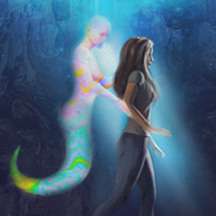
Realms Invisible To Us
Invisible beings have always played an oversized role in human story telling. Gilgamesh, the first story found in the historical record, pitted a Sumerian King against the unseen Anunnaki. Early in the development of my story, I decided that parallel character types were essential. How to accomplish this was decided by the Goldilocks method. Angels were too warm, aliens were too cold, but the anca were just right.
Pictured above, on the left, is an invisible anca named Noutashi. She is influencing the inner inspirations of a visible human named Melona.
The way the main anca characters emerged was quite sudden. I was on the commuter train, coming home from Manhattan after work. As usual, I was making story notes. Poof – four major characters appeared suddenly, out of nowhere. I scribbled rapidly to catch their fleeting impressions. After further development, these four became Riana and Dene, plus Cami and Farli. Writer’s instinct delivered them to me from somewhere out there in story land.
These characters quickly took over, especially Riana. That’s a good thing. They seemed to do a better job of knitting the plot together than what I had come up with. Many writers report that they’re quite happy when the characters take over.
Early on, I expected to finish this book using only humans and anca.
Whammo bammo. Another inspiration hit. What if some beings are invisible to us, but then there are also other beings who are invisible to them? That second group became the soto. They are similar to anca but they come from a different expansion region. In short order I had a new sub theme – Rescue of the Invisibles. That kept me going for quite a while.
##
In the back of my mind, I knew that bigger characters were also needed. The ishmili popped into my head, and they filled a necessary role, but they exist in a vague realm.
As I got deeper and deeper into this Gomonish worldview, a faint realization slowly filtered into my imagination. There was a nagging need for “supercluster-sized” characters. Then I drew a blank.
The End of the Sixties was almost finished when this huge, but totally unexpected, revelation rolled over me. With full force, very late in the game, flash beings were unleashed upon this cast of already fully developed characters.
Turns out that was a good thing. The End of the Sixties made it across the finish line, got self-published on Amazon, and then I took some time off. At first my mind went radio-silent on the subject of new story ideas. Then my writer’s instinct kicked back in again. Flash beings are going to be players in all of the sequels. Existing characters will be right there along with them, as well as new types.
Putting this in perspective, ishmili are more immense than anything we can easily visualize. Flash beings have stronger powers than we do, but they’re recognizable to us. Anca and soto are a lot like people, except they’re invisible.
We are not alone in this universe. I like to believe that each and every one of us will have our own personal role to play, in multiple realms of reality, throughout all of eternity.
Part 3 – Our Galaxy Ostramona
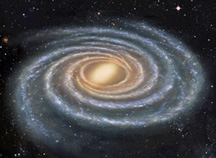
Our Galaxy In Fiction
Ostramona is the fictional name for our Milky Way galaxy. One sector of Ostramona is a star group named Roshomon and that is where Earth resides. Roshomon is also the site of a gargantuan construction project. A major industrial goal, of rival groups, is to combine parts from two expansion regions, into a local survival region.
This Roshomon JeshNim project will eventually become a module in a grid of survival networks.
In the far distant future, our Sun will go red giant and planet Earth will get fried to a crisp. Further down the cosmic road, our galaxy will become stretched so thin that stars will no longer form. Given enough time, our supercluster will dissipate into a raggedy form of nothingness. Beyond that, this nothingness will evaporate into the thinnest version of wispiness.
That’s why we’re building a survival sphere. It’s gonna come in handy.
Part 4 – Our Supercluster Gomonish
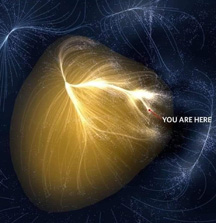
Our Home Supercluster in Fiction
On this map of our Gomonish supercluster there is a label, “You Are Here.” We didn’t know that twenty years ago. A simple experiment, which can be done in your kitchen sink, is an easy way to visualize the form of this tremendous geography.
Put an empty bowl in the sink. Add a dash of dish detergent. Turn the water on high. Soap bubbles will pile up. What you see in that bowl is a miniature version of the approximate shape of the cosmic web.
The inside of each soap bubble corresponds to a void. The surface of each soap bubble has a thin film of matter, which is analogous to the matter of which stars and planets are made. Where two soap bubbles meet, along a curved bubble-line, that is like a miniature version of where superclusters form. The physics of the cosmic web is very different from that of soap bubbles, but the outward forms are similar enough for you to visualize.
Leave the bowl in the sink overnight. In the morning there will be no more bubbles. If you went away for a very long time – the water in the bowl would eventually evaporate.
Worlds proliferate, age, fizzle, die, decay. Then the cycle renews itself by some majestic process. As we humans see in nature every spring, from winter’s decay comes summer’s revival. Exactly how that works has an air of mystery about it. The belief that our consciousness will survive beyond the grave is deeply embedded in every human culture. Where do we fit in this larger view?
Gomonish will be in our soap bubble among the stars for longer than anything else we know about. Ten million other superclusters will drift beyond our horizon. If there is eternal life then it must survive somewhere, somehow. Planets, stars, and galaxies will fade away. Our souls will continue to thrive. We will ultimately join with countless other souls, out there in the opportunities of eternity.
You, the reader, can take away from these stories whatever suits you. Many readers will be looking for entertainment. It’s there. Some readers will want something to think about. It’s there.
Gomonish will be our natural home among the stars. For the next few eons.
Part 5 – Supercluster Neighbor Vartog
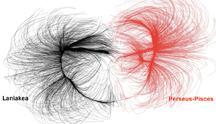
Supercluster Jump
This is the only picture the author found on the internet which shows how the opening chapter of The End of the Sixties actually works.
Riana is the primal anca who understands how to bring two mutually invisible expansion regions together. Dene is the tough guy anca sent in by the ishmili to keep the bad guys at bay. Frang is an ishmili who explains to Dene how he can reach Riana …
… Frang said to Dene, “This is Mezna – where you were, and Argulen – where you were going. Nearby is Vartog, where we put you in a safe place, here on planet Eetor. Over there is Gomonish, where Hamil and Hamine are currently located. We want you to find a grid line that you can use to get there in a hurry.” …
In the illustration above you can actually see how this works.
The black supercluster, marked Laniakea, is fictional Gomonish. The red supercluster, marked Perseus-Pisces, is fictional Vartog. Gravity grid lines extend out from both superclusters, like threads. Our home on Earth is near the end of one of those thin black lines, which almost touch one of the thin red lines. Dene makes that cosmic jump – red to black. Mezna and Argulen are neighboring superclusters, which are beyond the range of this picture.
In this story, the cast of invisible characters teaches a small group of humans, the Bopsies, how to mode-hop through this flexible cosmic environment. What any of us feel as our experience is never a full version of all the realities that surround us. Those invisible beings need visible characters, such as humans, to achieve their far-seeing goals. All of us have a role to play.
Stories help us to understand what is new and difficult. Characters and places have been created so that readers will have a familiar place to imagine this grand new geography. From this fictional version, of this larger view, we can reach a better understanding of our actual place among the stars.
Instead of “thar be dragons,” like they used to write on the old maps, these modern stories say, “thar be flash beings.”
Part 6 – Supercluster Geography
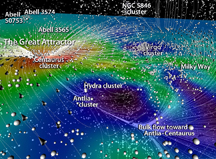
Superclusters and Voids
To give the reader a better feel for this image of cosmic geography (which is roughly 600 million light years wide) I’m going to start with a familiar analogy that is about 1000 miles wide.
In a novel of the western genre, a map of where the story takes place might show mountain ranges in green, valleys in red, while arid deserts would be depicted in black.
In the supercluster map shown above, the matter in green (Milky Way type) is at a “high altitude” of the space-time continuum. There are black void-valleys at the “lowest altitudes.” Gravity tugs matter along a “hillside,” shown in red.
This explanation is far from being a perfect analogy, but it has been quite useful during story development. For each of the different character types, it was necessary to imagine what this cosmic geography would look and feel like to them.
The bopsies, a small group of people from Earth, find themselves unexpectedly working with these anca, soto, flash beings, and ishmili. This supercluster geography is their new frontier.
These thoughts, these fictions, accompanied by these pictures, are something that this writer hopes you readers will consider. The continuing expansion of scientific insights have presented us with a new view. Let us internalize that deep time way of thinking about events, and become part of it.
Part 7 – Cosmic Web Local
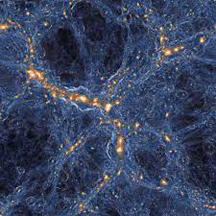
Gomonish Supercluster Region
This is what our Gomonish neighborhood looks like when surrounded by local features of the cosmic web.
To put this in perspective, Earth is 8 thousand miles wide, our solar system is 12 trillion miles wide, our galaxy is 100 thousand light years wide, and the Gomonish supercluster region (shown above) is 250 million light years wide. These locations are where the Deep Time Stories take place.
This rendering of our home-in-the-sky does not resemble anything we imagined while growing up. The concept of superclusters was established in the 1970s, but it wasn’t until 2014 that Laniakea (Gomonish) was identified as “our” supercluster. The large black shapes are vast void bubbles. Those bright yellow spots are superclusters. Light blue threads are the three-dimensional gravity grid, which form the cosmic web.
Our time on planet Earth will come to an end someday. This author’s belief is that our next phase of life will be in a parallel realm nearby. Eventually we will travel to countless other realms. Our personal perception of space-time is likely to shift when we transfer from one form to another. Our local supercluster has plenty to offer for that part of this journey. After then, we will probably move away to distant sectors of the universe.
Where we live is less important than how we live. Here on Earth, when I move into a new home, I always try to leave it better than the way I found it. On our long cosmic journey, the same sort of custom should apply. Leave the planet better than you found it. We humans are not doing a very good job of that right now.
The Deep Time Stories have a straightforward goal. Create a backstory with characters and places which enable the reader to visualize this enlarged supercluster way of life. Then, entertain them with shifting tales of adventure.
Our ancestors created campfire stories that took place in the starry skies, as seen by human eyes. These recent stories extend those traditions by including insights from high tech telescopes.
Our future will be spent living in Deep Time. Millions, billions, and trillions of years will pass. We will still have all of eternity ahead of us. It would be nice if we learned how to live lives that are worthy of such a future.
Take a fresh look at the picture above. Do we expect to conquer everything we see – arriving in space ships, blasting planets, seeking conquest? That doesn’t make sense. On a planet, you can blast and conquer. In a supercluster, that’s not a workable plan. On the other hand, those who are filled with greed, will always desire more.
What if there was a region called the Earth Hub? What if that zone surrounding our planet was going to be very important to the future lives of countless beings? How should we live our lives – right here, right now – to uphold their future interests?
Deep Time. To superclusters and beyond.
Part 8 – Helping Hands

Our Blog Community
This writer welcomes opinions from you readers.
The End of the Sixties got the game going. Sequels are being prepared. It would be nice to hear your beliefs.
It’s a big universe out there and they need us somewhere. If there is eternal life, which I believe, then all beings with souls must exist in some sort of dimension. After leaving Earth, you and I will join with others, under circumstances which we are unable to predict. My feeling is that no matter how big the universe is, and however many other types of beings occupy endless realms, we will always have our own personal role to play.
It takes a village to raise a child. It takes an internet community to understand what it means to be living within the deep time of a supercluster environment.
Your helping hands are welcome.